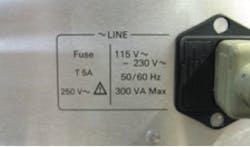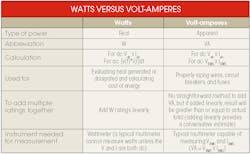This article is part of the Power Management Series: What’s the Difference Between Watts, RMS, and More?
Download this article in .PDF format
Both watts (W) and volt-amperes (VA) are units of measurement for electrical power. Watts refer to “real power,” while volt-amperes refer to “apparent power.” Usually, electronic products show one or both of these values to provide information about how much energy they will consume or how much current they will draw. Each of these values can be used for various purposes.
What Are Watts?
The real power in watts is the power that performs work or generates heat. Power in watts is the rate at which energy is consumed (or generated). One watt is one joule (energy) per second (1 W = 1 J/s). You pay your utility company for watts expressed as energy, which is power consumed for a time period, typically shown by your utility company in kilowatt-hours. For example, a 100-W light bulb left on for 10 hours consumes 1 kW-hour of energy (100 W x 10 hours = 1000 W-hours = 1 kW-hour).
How Are Watts Calculated?
Real power for dc circuits is simply the voltage (Vdc) times the current (Idc):
W = Vdc x Idc (1)
The concept for calculating the real power for ac circuits is straightforward, though performing the calculation is much more difficult. To get the power in watts, you need to know the instantaneous voltage with time, v(t), and the instantaneous current with time, i(t). When you multiply these together, you get the instantaneous power with time, p(t).
Since this instantaneous power is changing over time, we need to get an average value, so we integrate the power over a period of time and divide by the time period to get the average. That gives us the watts dissipated by the device in a circuit with voltage v(t) across it and current i(t) through it for the period of time evaluated. Assuming that the voltage and current are both periodic waveforms of period T, the strict mathematical way to express the power calculation for a periodic waveform of period T is:
(2)
So while this may be easy to visualize, it is not easy to calculate. Even the measurement of real power in watts for ac circuits requires specialized equipment (a wattmeter) because the voltage and current waveforms must be measured over a precise period of time, the measurements must be simultaneous, and the average must be calculated over the measurement time period. A standard multimeter can’t make this type of power measurement.
What Are Watts Used For?
These ratings are useful if you have to get rid of the heat generated by the device consuming the watts or if you want to know how much you will pay your utility company to use your device since you pay for kilowatt-hours (power used for a period of time). To combine the real power of multiple dc or ac devices, you can just add up the individual power ratings in watts of each device to get the total power (watts add linearly).
What Are Volt-Amperes?
The apparent power in VA is used to simplify power ratings, making it easier to calculate current draw. Since VA = RMS volts x RMS amps, you can divide the VA rating by your RMS voltage to get the RMS current the device will draw. Knowing the RMS current helps you properly size wires and circuit breakers or fuses that supply current to your device.
How Are Volt-Amperes Calculated?
The apparent power for dc circuits is simply the voltage (Vdc) times the current (Idc):
VA = Vdc x Idc (3)
The apparent power for dc circuits is the same as real power for dc circuits (for dc, VA = W).
For ac circuits, VA are the product of the RMS voltage (VRMS) times the RMS current (IRMS):
VA = VRMS x IRMS (4)
You can calculate the apparent power in volt-amperes for ac circuits by multiplying the measured RMS voltage times the measured RMS current. A standard multimeter usually can make both of these RMS measurements.
What Are Volt-Amperes Used For?
Volt-amperes provide insight into the amount of current drawn by a product or circuit, assuming you know the voltage. For example, the standard residential voltage in the United States is 120 VRMS. If a product is rated for 300 VA (the rating implies this is the maximum VA the product will draw) and is powered from a 120-VRMS ac line voltage, you can calculate the expected maximum current as 300 VA/120 VRMS = 2.5 ARMS maximum (see the figure). Thus, you would want to ensure that the wires and associated circuitry supplying this product accommodate at least 2.5 ARMS.
To combine the apparent power of multiple dc devices, volt-amperes add linearly. However, to combine the apparent power (or current) of multiple ac devices, there is no straightforward way to get an exact total because the currents for each device are not necessarily in phase with each other, so they don’t add linearly. But if you do simply add the individual VA ratings (or currents) together, the total will be a conservative estimate to use since the actual total will always be less than or equal to this value.
Another term that is useful in this discussion is power factor (PF). The power factor is defined as the ratio of W to VA:
Power factor = PF = W/VA (5)
Power factor is always a number between zero and one because the watts drawn by a device are always less than or equal to the volt-amperes. Note that it is possible for a circuit to have a large voltage across it and to draw substantial current, but consume no energy (dissipate zero watts).
While this seems counterintuitive, it is true if the circuit is purely reactive (a pure capacitor or pure inductor). The circuit will do no work and produce no heat, so it is drawing (and dissipating) zero watts. Yet it can draw substantial current, resulting in substantial VA.
In this case, the power factor is zero. This is possible because the phase relationship between the voltage and current waveforms is such that the circuit is alternately absorbing real power and giving that real power back, so the net real power consumption is zero.
Summary
W and VA are both units of measurement for power, but that’s where the similarity ends. Watts do work or generate heat, while volt-amperes simply provide you with information you need to size wires, fuses, or circuit breakers. Watts add linearly, while volt-amperes doe not. And to measure W, you need a special wattmeter. You can calculate VA by using a standard multimeter to measure VRMS and IRMS and finding the product (see the table).
Read more from the Power Management Series: What’s the Difference Between Watts, RMS, and More?



